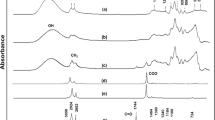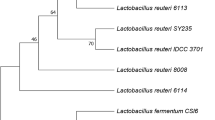Abstract
Three probiotic Lactobacillus strains, Lactobacillus acidophilus, Lactobacillus plantarum, and Lactobacillus delbrueckii, were tested for their ability to assimilate and metabolize glycerol. Biodiesel-derived glycerol was used as the main carbon and energy source in batch microaerobic growth. Here, we show that the tested strains were able to assimilate glycerol, consuming between 38 and 48 % in approximately 24 h. L. acidophilus and L. delbrueckii showed a similar growth, higher than L. plantarum. The highest biomass reached was 2.11 g L−1 for L. acidophilus, with a cell mass yield (Y X/S) of 0.37 g g−1. L. delbrueckii and L. plantarum reached a biomass of 2.06 and 1.36 g L−1. All strains catabolize glycerol mainly through glycerol kinase (EC 2.7.1.30). For these lactobacillus species, kinetic parameters for glycerol kinase showed Michaelis–Menten constant (K m) ranging from 1.2 to 3.8 mM. The specific activities for glycerol kinase in these strains were in the range of 0.18 to 0.58 U mg protein−1, with L. acidophilus ATCC 4356 showing the maximum specific activity after 24 h of cultivation. Glycerol dehydrogenase activity was also detected in all strains studied but only for the reduction of glyceraldehyde with NADPH (K m for DL-glyceraldehyde ranging from 12.8 to 32.3 mM). This enzyme shows a very low oxidative activity with glycerol and NADP+ and, most likely, under physiological conditions, the oxidative reaction does not occur, supporting the assumption that the main metabolic flux concerning glycerol metabolism is through the glycerol kinase pathway.





Similar content being viewed by others
References
Altermann E, Russell WM, Azcarate-Peril MA, Barrangou R, Buck BL, McAuliffe O, Souther N, Dobson A, Duong T, Callanan M, Lick S, Hamrick A, Cano R, Klaenhammer TR (2005) Complete genome sequence of the probiotic lactic acid bacterium Lactobacillus acidophilus NCFM. Proc Natl Acad Sci USA 102(11):3906–3912
Alvarez MD, Medina R, Pasteris SE, de Saad AMS, Sesma F (2004) Glycerol metabolism of Lactobacillus rhamnosus ATCC 7469: Cloning and expression of two glycerol kinase genes. J Mol Microb Biotech 7(4):170–181
Aragon CC, Ferreira-Dias S, Gattas EAD, Peres MDS (2008) Characterization of glycerol kinase from baker's yeast: response surface modeling of the enzymatic reaction. J Mol Catal B-Enzym 52–3:113–120
Axelsson L (2004) Lactic acid bacteria: classification and physiology. In: Salminen S, Wright A, Ouwehand A (eds) Lactic acid bacteria—microbiological and functional aspects, 3rd edn. Marcel Dekker, New York, pp 1–66
Berger B, Pridmore RD, Barretto C, Delmas-Julien F, Schreiber K, Arigoni F, Brussow H (2007) Similarity and differences in the Lactobacillus acidophilus group identified by polyphasic analysis and comparative genomics. J Bacteriol 189(4):1311–1321
Brisson D, Vohl MC, St-Pierre J, Hudson TJ, Gaudet D (2001) Glycerol: a neglected variable in metabolic processes? Bioessays 23(6):534–542
Consortium U (2012) Reorganizing the protein space at the Universal Protein Resource (UniProt). Nucleic Acids Res 40(D1):D71–D75
De Angelis M, Bini L, Pallini V, Cocconcelli PS, Gobbetti M (2001) The acid-stress response in Lactobacillus sanfranciscensis CB1. Microbiology 147(Pt 7):1863–1873
Hayashi SI, Lin EC (1967) Purification and properties of glycerol kinase from Escherichia coli. J Biol Chem 242(5):1030–1035
Holmberg C, Beijer L, Rutberg B, Rutberg L (1990) Glycerol catabolism in Bacillus subtilis: nucleotide sequence of the genes encoding glycerol kinase (glpK) and glycerol-3-phosphate dehydrogenase (glpD). J Gen Microbiol 136(12):2367–2375
Holmberg C, Rutberg B (1989) Cloning of the glycerol kinase gene of Bacillus subtilis. FEMS Microbiol Lett 49(2–3):151–155
Huang HS, Yoshida T, Meng Y, Kabashima T, Ito K, Nishiya Y, Kawamura Y, Yoshimoto T (1997) Purification and characterization of thermostable glycerol kinase from Thermus flavus. J Ferment Bioeng 83(4):328–332
Kanehisa M, Goto S (2000) KEGG: kyoto encyclopedia of genes and genomes. Nucleic Acids Res 28(1):27–30
Kleerebezem M, Boekhorst J, van Kranenburg R, Molenaar D, Kuipers OP, Leer R, Tarchini R, Peters SA, Sandbrink HM, Fiers MW, Stiekema W, Lankhorst RM, Bron PA, Hoffer SM, Groot MN, Kerkhoven R, de Vries M, Ursing B, de Vos WM, Siezen RJ (2003) Complete genome sequence of Lactobacillus plantarum WCFS1. Proc Natl Acad Sci USA 100(4):1990–1995
Lages F, Silva-Graca M, Lucas C (1999) Active glycerol uptake is a mechanism underlying halotolerance in yeasts: a study of 42 species. Microbiol-Uk 145:2577–2585
Liepins J, Kuorelahti S, Penttila M, Richard P (2006) Enzymes for the NADPH-dependent reduction of dihydroxyacetone and D-glyceraldehyde and L-glyceraldehyde in the mould Hypocrea jecorina. FEBS J 273(18):4229–4235
Lin EC, Magasanik B (1960) The activation of glycerol dehydrogenase from Aerobacter aerogenes by monovalent cations. J Biol Chem 235:1820–1823
Lorca GL, de Valdez GF (2001) A low-pH-inducible, stationary-phase acid tolerance response in Lactobacillus acidophilus CRL 639. Curr Microbiol 42(1):21–25
Lorquet F, Goffin P, Muscariello L, Baudry JB, Ladero V, Sacco M, Kleerebezem M, Hols P (2004) Characterization and functional analysis of the poxB gene, which encodes pyruvate oxidase in Lactobacillus plantarum. J Bacteriol 186(12):3749–3759
Luyten K, Albertyn J, Skibbe WF, Prior BA, Ramos J, Thevelein JM, Hohmann S (1995) Fps1, a yeast member of the Mip family of channel proteins, is a facilitator for glycerol uptake and efflux and is inactive under osmotic-stress. EMBO J 14(7):1360–1371
Makarova K, Slesarev A, Wolf Y, Sorokin A, Mirkin B, Koonin E, Pavlov A, Pavlova N, Karamychev V, Polouchine N, Shakhova V, Grigoriev I, Lou Y, Rohksar D, Lucas S, Huang K, Goodstein DM, Hawkins T, Plengvidhya V, Welker D, Hughes J, Goh Y, Benson A, Baldwin K, Lee JH, Diaz-Muniz I, Dosti B, Smeianov V, Wechter W, Barabote R, Lorca G, Altermann E, Barrangou R, Ganesan B, Xie Y, Rawsthorne H, Tamir D, Parker C, Breidt F, Broadbent J, Hutkins R, O'Sullivan D, Steele J, Unlu G, Saier M, Klaenhammer T, Richardson P, Kozyavkin S, Weimer B, Mills D (2006) Comparative genomics of the lactic acid bacteria. Proc Natl Acad Sci USA 103(42):15611–15616. doi:10.1073/pnas.0607117103
Myint LL, El-Halwagi MM (2009) Process analysis and optimization of biodiesel production from soybean oil. Clean Technol Envir 11(3):263–276. doi:10.1007/s10098-008-0156-5
Nikel PI, Giordano AM, de Almeida A, Godoy MS, Pettinari MJ (2010) Elimination of D-lactate synthesis increases poly(3-hydroxybutyrate) and ethanol synthesis from glycerol and affects cofactor distribution in recombinant Escherichia coli. Appl Environ Microb 76(22):7400–7406
OECD-FAO (2011) Biofuels. In: OECD-FAO (ed) OECD-FAO agricultural outlook 2011–2020. vol chapter 3. OECD, Rome, pp 76–92
Papanikolaou S, Fakas S, Fick M, Chevalot I, Galiotou-Panayotou M, Komaitis M, Marc I, Aggelis G (2008) Biotechnological valorisation of raw glycerol discharged after bio-diesel (fatty acid methyl esters) manufacturing process: production of 1,3-propanediol, citric acid and single cell oil. Biomass Bioenerg 32(1):60–71
Parvez S, Malik KA, Kang SA, Kim HY (2006) Probiotics and their fermented food products are beneficial for health. J Appl Microbiol 100(6):1171–1185
Pasteris SE, de Saad AMS (2009) Sugar-glycerol cofermentations by Lactobacillus hilgardii isolated from wine. J Agr Food Chem 57(9):3853–3858
Pettigrew DW, Ma DP, Conrad CA, Johnson JR (1988) Escherichia coli glycerol kinase. Cloning and sequencing of the Glpk gene and the primary structure of the enzyme. J Biol Chem 263(1):135–139
Pettigrew DW, Yu GJ, Liu YG (1990) Nucleotide regulation of Escherichia coli glycerol kinase: initial-velocity and substrate binding studies. Biochemistry 29(37):8620–8627
Prust C, Hoffmeister M, Liesegang H, Wiezer A, Fricke WF, Ehrenreich A, Gottschalk G, Deppenmeier U (2005) Complete genome sequence of the acetic acid bacterium Gluconobacter oxydans. Nat Biotechnol 23(2):195–200
Richter N, Neumann M, Liese A, Wohlgemuth R, Eggert T, Hummel W (2009) Characterisation of a recombinant NADP-dependent glycerol dehydrogenase from Gluconobacter oxydans and its application in the production of L-glyceraldehyde. ChemBioChem 10(11):1888–1896
Rittmann D, Lindner SN, Wendisch VF (2008) Engineering of a glycerol utilization pathway for amino acid production by Corynebacterium glutamicum. Appl Environ Microb 74(20):6216–6222
Todorov SD (2008) Bacteriocin production by Lactobacillus plantarum AMA-K isolated from Amasi, a Zimbabwean fermented milk product and study of the adsorption of bacteriocin AMA-K to Listeria sp. Braz J Microbiol 39(1):178–187
Veiga da Cunha MV, Foster MA (1992) Sugar-glycerol cofermentations in lactobacilli: the fate of lactate. J Bacteriol 174(3):1013–1019
Voegele RT, Sweet GD, Boos W (1993) Glycerol kinase of Escherichia coli is activated by interaction with the glycerol facilitator. J Bacteriol 175(4):1087–1094
Weber AL (1987) The triose model: glyceraldehyde as a source of energy and monomers for prebiotic condensation reactions. Orig Life Evol B 17(2):107–119
Wei S, Song Q, Wei D (2007) Production of Gluconobacter oxydans cells from low-cost culture medium for conversion of glycerol to dihydroxyacetone. Prep Biochem Biotechnol 37(2):113–121
Yamada H, Nagao A, Nishise H, Tani Y (1982) Studies on microbial glycerol dehydrogenase. 1. Formation of glycerol dehydrogenase by microorganisms. Agr Biol Chem Tokyo 46(9):2325–2331
Yamada K, Tani Y (1988) Glycerol dehydrogenase and dihydroxyacetone reductase of a methylotrophic yeast, Hansenula ofunaensis. Agr Biol Chem Tokyo 52(3):711–719
Yamada-Onodera K, Yamamoto H, Emoto E, Kawahara N, Tani Y (2002) Characterisation of glycerol dehydrogenase from a methylotrophic yeast, Hansenula polymorpha Dl-1, and its gene cloning. Acta Biotechnol 22:337–353
Yazdani SS, Gonzalez R (2007) Anaerobic fermentation of glycerol: a path to economic viability for the biofuels industry. Curr Opin Biotech 18(3):213–219
Zhang JZ (2003) Evolution by gene duplication: an update. Trends Ecol Evol 18(6):292–298
Acknowledgments
The authors gratefully acknowledge the financial support of Fundação de Amparo à Pesquisa do Estado de São Paulo—FAPESP (Process No. 2008/57447-9). Juan D. Rivaldi also thanks to the International Mobility Program for Postgraduate Students—Banco Santader-USP-2010. Support was also provided by project PEst-OE/QUI/UI0612/2011 from Fundação para a Ciência e a Tecnologia, Portugal.
Conflict of Interest
None.
Author information
Authors and Affiliations
Corresponding author
Rights and permissions
About this article
Cite this article
Rivaldi, J.D., Sousa Silva, M.L.C., Duarte, L.C. et al. Metabolism of biodiesel-derived glycerol in probiotic Lactobacillus strains. Appl Microbiol Biotechnol 97, 1735–1743 (2013). https://doi.org/10.1007/s00253-012-4621-z
Received:
Revised:
Accepted:
Published:
Issue Date:
DOI: https://doi.org/10.1007/s00253-012-4621-z




